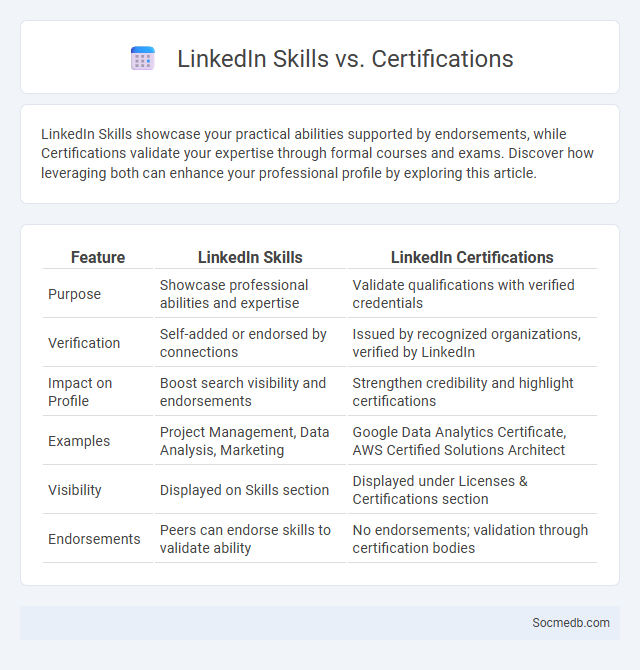
Photo illustration: LinkedIn Skills vs Certifications
LinkedIn Skills showcase your practical abilities supported by endorsements, while Certifications validate your expertise through formal courses and exams. Discover how leveraging both can enhance your professional profile by exploring this article.
Table of Comparison
| Feature | LinkedIn Skills | LinkedIn Certifications |
|---|---|---|
| Purpose | Showcase professional abilities and expertise | Validate qualifications with verified credentials |
| Verification | Self-added or endorsed by connections | Issued by recognized organizations, verified by LinkedIn |
| Impact on Profile | Boost search visibility and endorsements | Strengthen credibility and highlight certifications |
| Examples | Project Management, Data Analysis, Marketing | Google Data Analytics Certificate, AWS Certified Solutions Architect |
| Visibility | Displayed on Skills section | Displayed under Licenses & Certifications section |
| Endorsements | Peers can endorse skills to validate ability | No endorsements; validation through certification bodies |
Understanding LinkedIn Skills: An Overview
LinkedIn skills are essential markers that showcase professional competencies and expertise, enabling recruiters to identify qualified candidates effectively. These skills range from technical abilities like programming languages to soft skills such as leadership, which users can endorse to validate credibility. Optimizing your LinkedIn profile by strategically selecting and updating skills enhances visibility in search results and networking opportunities within specific industries.
The Role of Certifications on LinkedIn
Certifications on LinkedIn significantly enhance your professional credibility by showcasing verified skills and expertise to potential employers. They improve your visibility in search results within LinkedIn's algorithm, increasing opportunities for networking and job offers. Leveraging relevant certifications tailored to your industry can position you as a dedicated and knowledgeable candidate in your field.
What is Social Proof on LinkedIn?
Social proof on LinkedIn refers to the validation your profile, posts, or company receive through endorsements, recommendations, and user interactions like comments and shares. It demonstrates credibility and trustworthiness by showcasing how others perceive and engage with your professional brand. Leveraging social proof effectively increases your visibility and influence within your network.
Skills vs. Certifications: Key Differences
Skills in social media management encompass practical abilities like content creation, audience engagement, and analytics interpretation, which are crucial for effective campaign execution. Certifications validate these competencies through formal assessments and standardized curricula, providing external proof of expertise and often enhancing credibility with employers or clients. Emphasizing skill development fosters adaptability in rapidly evolving platforms, while certifications offer structured knowledge and recognized benchmarks within the industry.
How Social Proof Influences LinkedIn Credibility
Social proof significantly enhances your LinkedIn credibility by showcasing endorsements, recommendations, and follower counts that validate your professional expertise. Displaying positive interactions and testimonials from industry peers builds trust and encourages connections to view your profile as reliable and authoritative. Leveraging social proof strategically boosts your visibility and attracts valuable networking and career opportunities on LinkedIn.
Which Matters More: Endorsements or Certificates?
Endorsements often carry more weight on social media due to their direct connection with real user experiences and trust-building impact, while certificates primarily highlight formal qualifications. Your credibility can be significantly boosted when endorsements reflect genuine appreciation from peers or customers, enhancing your social proof. Balancing both with a focus on authentic social validation ensures stronger influence and engagement across platforms.
Building a Balanced LinkedIn Profile
Creating a balanced LinkedIn profile involves showcasing professional achievements, skills, and endorsements alongside a clear, engaging summary that highlights expertise and career goals. Including a professional profile photo, customized headline, and detailed work experience increases visibility and credibility within industry networks. Regularly updating the profile with relevant content and engaging with connections fosters a strong personal brand and expanded professional opportunities.
Strategies for Showcasing Skills Effectively
Highlight your skills on social media by creating a cohesive and visually appealing portfolio that demonstrates your expertise through project showcases, case studies, and client testimonials. Use targeted hashtags and engaging content formats like videos, infographics, and tutorials to increase visibility and attract relevant audiences. Consistently update your profiles with fresh work and interact with industry leaders to enhance your credibility and professional network.
Leveraging Social Proof to Boost Career Prospects
Leveraging social proof on social media platforms enhances career prospects by showcasing endorsements, recommendations, and positive interactions from peers and industry leaders. Displaying authentic testimonials and engaged follower communities builds credibility and trust with potential employers or clients. Consistent positive social proof signals expertise and professionalism, making candidates more attractive in competitive job markets.
Choosing the Best Path: Skills, Certifications, or Social Proof?
Choosing the best path in social media marketing depends on leveraging relevant skills such as content creation and analytics to drive engagement effectively. Obtaining certifications from platforms like Facebook Blueprint and Google Ads can enhance credibility and demonstrate expertise to potential clients or employers. Building social proof through consistent positive reviews, testimonials, and active audience interaction ultimately establishes trust and influences decision-making.
 socmedb.com
socmedb.com